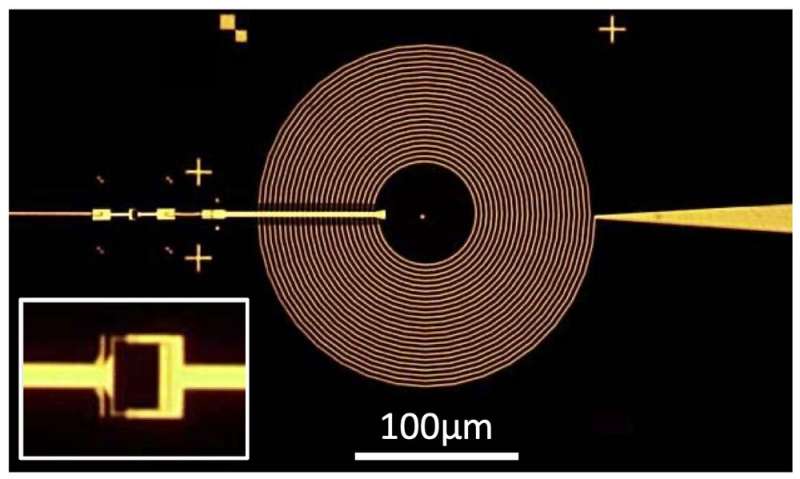This superconducting circuit, made from niobium on a quartz substrate, can emit bunches of up to six microwave photons. The inset shows a close-up of the Josephson junction used to inject charge carriers at a specified energy into the resonator. Credit: G. C. Ménard et al, Physical Review X (2022). DOI: 10.1103/PhysRevX.12.021006
A team of researchers with members from Universit´e Paris-Saclay, the University of Ulm and the Institute of Quantum Technologies has developed an on-chip circuit that produces up to six microwave photons at the same time. In their paper published in the journal Physical Review X, the group describes how they built the device, how well it worked, and its possible use as a more efficient way to produce entangled particles.
In recent years, scientists and engineers have found multiple uses for entangled particles and have been looking for a way to produce them more efficiently. They are generally created using a device that splits a single photon into two photons, each with less energy. In this new effort, the researchers have taken a different approach—using a superconducting circuit.
The circuit was designed using a Josephson junction, a coil inductor and a capacitor placed on a chip-sized base. A Josephson junction is a device with two strips of superconductors placed on a base plate a short distance apart. An insulating barrier is then set between them. Applying voltage to one of the strips pushes the voltage through the insulator, where Cooper pairs of electrons are created. These tunnel through the barrier, and the amount of energy they have is dependent on the amount of voltage applied.
In the new circuit, the coil inductor and the capacitor were tuned so that they would resonate at microwave frequencies, and the number of photons emitted by the device was dependent on the voltage applied. The device is capable of producing six photons at the same time. The researchers did not test the photons to determine if they were entangled, but believe they were based on prior experiments they had conducted. They also did not attempt to modify the device to determine if more than six photons could be produced. More testing is required, but if the device works as hoped, it could signal the start of a new wave of research based on groups of entangled particles.
More information: G. C. Ménard et al, Emission of Photon Multiplets by a dc-Biased Superconducting Circuit, Physical Review X (2022). DOI: 10.1103/PhysRevX.12.021006
Journal information: Physical Review X
© 2022 Science X Network
























